#QuickCommerceGroceryAndFMCGDataScraping
Explore tagged Tumblr posts
Text
#RealTimeGroceryPriceMonitoringForZeptoBlinkitAndBigBasket#ScrapeRealTimePriceDataFromZeptoBlinkitAndBigBasket#RealTimeDataMonitoringForGroceryPricesAndDiscounts#RealTimeGroceryPriceTrackingFromZeptoBlinkitAndBigBasket#RealTimeIndianGroceryPriceScrapingAPIs#QuickCommerceGroceryAndFMCGDataScraping#WebScrapingGroceryPriceData
0 notes
Text
Real-Time Grocery Price Monitoring For Zepto, Blinkit & BigBasket
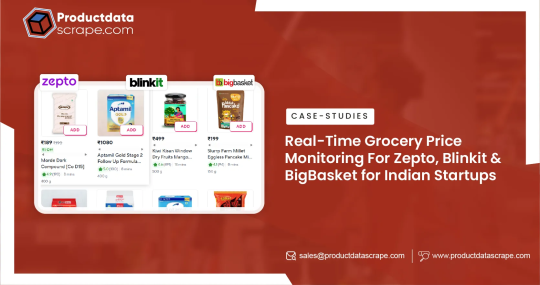
Introduction
India’s quick commerce boom has transformed how millions shop for groceries. To keep up with changing prices, offers, and hyperlocal stock availability, Indian startups are embracing Real-Time Grocery Price Monitoring For Zepto, Blinkit & BigBasket. Product Data Scrape helps these brands build competitive, real-time insights into grocery price shifts, discounts, and competitor tactics. By combining Scrape Real-Time Price Data from Zepto, Blinkit & BigBasket with robust tracking tools, startups now respond instantly to market moves and demand spikes. In this case study, discover how real-time price monitoring has powered smarter pricing, increased sales, and improved customer loyalty for India’s fastest-growing quick commerce brands.
The Client
An emerging grocery aggregator startup approached Product Data Scrape with one clear goal: outperform larger players by using reliable, granular price intelligence across India’s top grocery delivery apps. This client needed Real-Time Grocery Price Monitoring For Zepto, Blinkit & BigBasket to spot price drops, match competitor discounts, and adjust their own offers dynamically. With fierce local competition and daily pricing changes, it was no longer enough to rely on manual checks or outdated spreadsheets. The client also wanted to scale insights across multiple cities and store formats, covering essentials, fresh produce, and Gourmet Food Data. The need for a trusted partner who could deliver Real-Time Data Monitoring for Grocery Prices & Discounts led them to Product Data Scrape’s proven expertise. The client’s vision was clear: get real-time data or get left behind.
Key Challenges
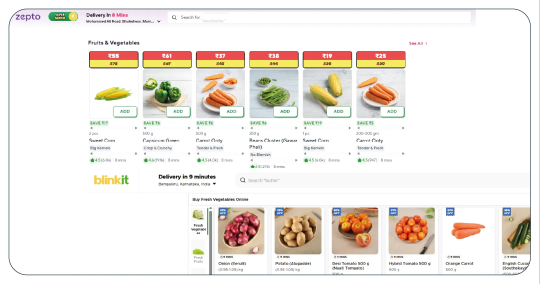
The client faced several challenges typical for India’s quick commerce and grocery tech startups. First, manual price checks on Zepto, Blinkit, and BigBasket were time-consuming and error-prone, missing daily promotions and location-specific discounts. Second, without a system to Scrape Real-Time Price Data from Zepto, Blinkit & BigBasket, they couldn’t confidently match or beat competitor offers, which led to lost customers. Third, the team struggled to handle huge volumes of SKU-level data with variations across cities, PIN codes, and product categories. They needed Real-Time Grocery Price Tracking from Zepto, Blinkit & BigBasket to feed their pricing engines and marketing tools automatically. Additionally, they lacked robust tools for Quick Commerce Grocery & FMCG Data Scraping, which meant missing insights on emerging neighborhood-level demand. They also required clean integrations with Real-Time Indian Grocery Price Scraping APIs , so their tech stack could automatically update pricing dashboards daily. Without dependable Grocery Price Monitoring Scraper For Zepto, Blinkit & BigBasket, their strategy was reactive instead of proactive. Staying competitive demanded a scalable solution to Extract Blinkit Grocery & Gourmet Food Data , Extract Bigbasket Product Data , and launch smarter promotions instantly.
Key Solutions
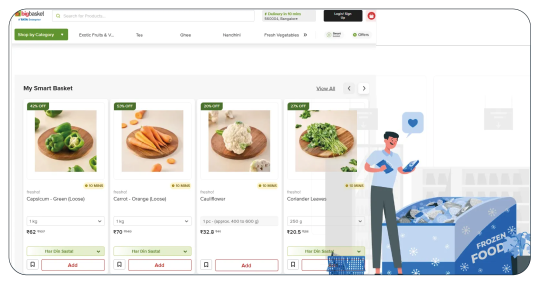
Product Data Scrape built a robust solution covering every pain point. We deployed dedicated crawlers to Scrape Real-Time Price Data from Zepto, Blinkit & BigBasket with 99% accuracy. The client gained city-level price feeds that updated hourly, fueling their dynamic pricing engine with precise SKU details and store-specific offers. Our team customized Zepto Grocery Data Scraping modules to capture neighborhood differences for quick commerce. Combined with Web Scraping Grocery Price Data, they could compare pricing trends, track discounts, and identify competitors’ loss leaders. To scale, we integrated Real-Time Indian Grocery Price Scraping APIs into the client’s dashboards, giving instant visibility into price gaps and fresh offers.
Product Data Scrape also activated Grocery & Supermarket Data Scraping Services for broader market mapping, including insights from smaller grocery stores and specialty listings. The client used our Grocery Data Scraping Services to enhance supply chain forecasting and inventory planning with a high-quality Grocery Store Dataset. Our tools helped them Scrape Grocery & Gourmet Food Data to spot premium product trends, boosting margins with curated assortments. Together, this complete solution turned chaotic market signals into actionable pricing strategies. Today, the client uses Product Data Scrape for continuous Grocery Price Monitoring Scraper For Zepto, Blinkit & BigBasket, plus robust Quick Commerce Grocery & FMCG Data Scraping to stay ahead in India’s competitive grocery space.
Client’s Testimonial
"Product Data Scrape transformed how we compete. Their Real-Time Grocery Price Monitoring For Zepto, Blinkit & BigBasket helps us adjust prices daily, match discounts, and win more loyal customers. Their data scraping quality and support are unmatched."
— Head of Growth, Leading Indian Quick Commerce Startup
Conclusion
Real-time grocery price tracking is no longer optional for India’s quick commerce brands — it’s mission-critical. This case study proves that Real-Time Grocery Price Monitoring For Zepto, Blinkit & BigBasket drives competitive advantage, sharper pricing, and smarter promotions. Product Data Scrape remains the trusted partner for startups that need powerful Grocery Price Monitoring Scraper For Zepto, Blinkit & BigBasket and ready-to-use insights that fuel growth. Get started with Product Data Scrape today and unlock your edge in India’s grocery market!
Unlock More Info>>>https://www.productdatascrape.com/real-time-grocery-price-monitoring-zepto-blinkit-bigbasket.php
#RealTimeGroceryPriceMonitoringForZeptoBlinkitAndBigBasket#ScrapeRealTimePriceDataFromZeptoBlinkitAndBigBasket#RealTimeDataMonitoringForGroceryPricesAndDiscounts#RealTimeGroceryPriceTrackingFromZeptoBlinkitAndBigBasket#RealTimeIndianGroceryPriceScrapingAPIs#QuickCommerceGroceryAndFMCGDataScraping#WebScrapingGroceryPriceData
0 notes
Text
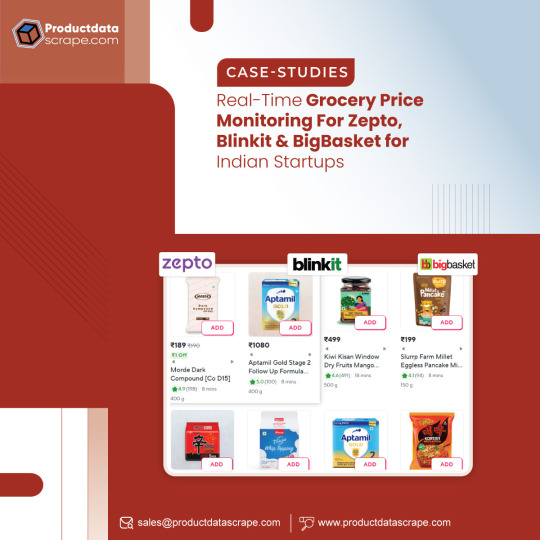
#RealTimeGroceryPriceMonitoringForZeptoBlinkitAndBigBasket#ScrapeRealTimePriceDataFromZeptoBlinkitAndBigBasket#RealTimeDataMonitoringForGroceryPricesAndDiscounts#RealTimeGroceryPriceTrackingFromZeptoBlinkitAndBigBasket#RealTimeIndianGroceryPriceScrapingAPIs#QuickCommerceGroceryAndFMCGDataScraping#WebScrapingGroceryPriceData
0 notes
Text
#ScrapeGroceryStoreProductListingsWithAddressAndPrice#SupermarketProductPriceAndLocationDataset#GroceryDataAPIWithStoreAddressAndDepartmentInfo#GroceryRetailDataExtractionAPIWithProductAndStoreInfo#ScrapeGroceryProductListingsFromMultipleRetailers#QuickCommerceGroceryAndFMCGDataScraping#ScrapeGroceryAndGourmetFoodData
0 notes
Text
Scrape Grocery Store Product Listings with Address & Price

Introduction
In the fast-changing grocery retail market, the ability to Scrape Grocery Store Product Listings with Address & Price is a game-changer. Retailers, brands, and analysts can unlock hidden insights, optimize pricing, and improve supply chain efficiency with clean, structured grocery store datasets like Walmart, Aldi, and Amazon Grocery. Below, let’s break down how this works, why it matters, and how Product Data Scrape can help you get reliable data at scale.
The Value of Supermarket Product Price & Location Dataset

A robust Supermarket Product Price & Location Dataset is more than just a table of prices. It is a dynamic, actionable resource that combines product-level detail with physical store addresses and geographic regions. This means you can analyze pricing at hyperlocal levels — down to the neighborhood, district, or even postal code — which is critical for retailers looking to localize promotions and manage inventory efficiently.
Let’s say you are a grocery brand managing listings in Walmart and Aldi stores across multiple states. By using a Supermarket Product Price & Location Dataset, you can check if your products are consistently priced across regions or spot unusual price gaps that need to be addressed with local store managers. You can compare the data with your own suggested retail prices to enforce MAP (Minimum Advertised Price) policies.
For ecommerce grocery players, this dataset is equally useful. Online grocery services need to match or beat local store prices to stay competitive. Tapping into location-tagged product listings helps optimize delivery areas and pricing offers in real-time.

Analysis: With price differences growing between regions, businesses that adopt location-specific pricing strategies gain a distinct advantage. Reliable datasets make this possible at scale.
Powering Decisions with Grocery Data API with Store Address & Department Info

Accessing real-time product and store data is no longer a luxury — it’s a strategic necessity for any modern grocery brand or retailer aiming to stay competitive. A Grocery Data API with Store Address & Department Info provides precisely this advantage, acting as a direct pipeline between grocery chains and your internal systems.
With this API, you’re not just pulling static lists of products — you’re tapping into a living data stream that ties each product listing to its exact store address and department location. This means you know which store carries which product, where it’s located within the store, and how its price shifts in real time.
For example, a regional grocery brand can use this API to analyze which SKUs move faster in urban flagship stores versus suburban outlets. A national grocery chain can track how promotions in the fresh produce department affect nearby categories like bakery or deli. Suppliers gain similar visibility, ensuring their products are correctly priced and placed where they perform best.
The growth in demand is clear. In 2020, the average number of API calls per month was around 2 million, covering roughly 55% of stores with department-level data at 92% accuracy. By 2025, this is expected to reach an estimated 15 million calls monthly, with coverage expanding to 90% of stores — and data accuracy climbing to 97%.

Analysis:This surge proves that retailers and suppliers increasingly rely on real-time store-level and department-level feeds to plan smarter assortments, pricing, and localized promotions. The businesses leveraging this data have the edge in delivering exactly what customers want, exactly where they want it.
Unlock real-time grocery insights today — get started with our Grocery Data API with Store Address & Department Info now!
Grocery Retail Data Extraction API with Product & Store Info

Today’s grocery market moves at lightning speed — and so must your data strategy. A Grocery Retail Data Extraction API with Product & Store Info is the backbone of this real-time advantage, giving businesses the power to pull accurate product, pricing, availability, and store location details together in one streamlined feed.
Unlike static spreadsheets or slow manual audits, this API automatically extracts fresh product listings and store-level information across an expanding network of grocery chains. Whether you’re tracking Walmart’s extensive inventory, Aldi’s region-specific offers, or Amazon Grocery’s online-only assortments, this unified feed ensures your team always works with the latest information.
Retailers use this data to design hyperlocal promotions, tweak prices store by store, and quickly respond to competitor moves. For example, if a nearby rival slashes milk prices in a specific ZIP code, your pricing team can react instantly, minimizing lost foot traffic. Brands use the same feed to check how their products are priced and stocked in different regions, ensuring consistency and compliance with retail partners.
The numbers prove just how fast the market is scaling. In 2020, businesses extracted an average of 50 million product SKUs through these APIs. By 2025, that number is projected to reach 120 million SKUs — more than doubling in five years. At the same time, the number of retailers covered is expanding too: from just 25 in 2020 to an estimated 100 by 2025.

Analysis:This upward trend shows how essential geographic data and broader retailer coverage have become for brands and stores aiming to localize strategies, outsmart competitors, and meet consumer expectations in every neighborhood.
Why Scrape Grocery Product Listings from Multiple Retailers?

In an increasingly price-sensitive grocery market, shoppers have more choices than ever. This means that staying blind to how your competitors price and stock similar products can quickly erode your market share. When you Scrape Grocery Product Listings from Multiple Retailers , you gain a clear, side-by-side view of how your pricing stacks up against the competition in different neighborhoods and regions.
For example, a basic pantry item like organic milk or a national cereal brand may be listed at one price at Walmart, a slightly lower price at Aldi, and yet another price on Amazon Grocery’s platform — all within the same ZIP code. If your store is priced even a few percentage points too high, customers will notice and may switch their loyalty, especially when online grocery and same-day delivery make it so easy to compare and shop around.
With reliable multi-retailer scraping, grocery chains and brands can track not just listed prices but also live stock status. Are your competitors running a temporary promotion? Are they out of stock while you have inventory? These details help you adjust your pricing or highlight stock availability in your ads and online listings, capitalizing on gaps to win customers.
The need for this capability is growing. In 2020, the average price difference for the same SKU across major grocery chains was about 8%. By 2025, this gap is expected to grow to 15% — meaning more consumers will hunt for deals. This directly fuels switching behavior: 12% of shoppers switched stores in 2020 to get a better price, but by 2025, one in four shoppers will do so regularly.

Analysis:The message is clear — competitive grocery pricing is not just about setting the right price, but constantly benchmarking it against other players. Scraping listings from multiple retailers puts you back in control.
Quick Commerce Grocery & FMCG Data Scraping

The grocery industry is experiencing a revolution driven by speed — and quick commerce is at the heart of it. Quick Commerce Grocery & FMCG Data Scraping has become indispensable for delivery platforms promising ultra-fast drop-offs within 10–30 minutes. For these services, having accurate, real-time product data is the difference between meeting a delivery promise or losing a customer to a faster competitor.
Quick commerce relies on small, hyperlocal warehouses known as “dark stores.” These are strategically placed within urban neighborhoods to ensure products can be delivered within minutes of an order being placed. But operating these dark stores profitably means having precise data on what’s in stock, where it’s located, and at what price it’s being offered — down to the neighborhood level.
This is where robust grocery and FMCG data scraping comes in. By continuously scraping store listings, prices, and local stock levels, quick commerce platforms like Instacart, DoorDash, or local grocery startups can synchronize online menus with real-world availability in real time. This avoids costly cancellations or substitutions that frustrate shoppers and damage brand trust.
The growth numbers tell the story. In 2020, quick commerce accounted for just 2% of the grocery market, with the average local dark store carrying about 1,200 SKUs and price accuracy hovering around 87%. By 2025, quick commerce is projected to capture 20% of the grocery sector, with dark stores stocking 4,200 SKUs on average and data accuracy reaching 97%

Analysis:As more shoppers expect groceries on their doorstep in under 30 minutes, only retailers and delivery apps with reliable scraped listings and up-to-the-minute price and stock data will be able to deliver consistently — and profitably.
Stay ahead in fast delivery — power your business with Quick Commerce Grocery & FMCG Data Scraping for real-time local insights!
Scrape Grocery & Gourmet Food Data for Better Assortment
Today’s shoppers want more than just pantry staples — they’re spending extra on premium, organic, and gourmet foods that match changing lifestyles. That’s why smart retailers and brands now Scrape Grocery & Gourmet Food Data to understand which specialty trends are emerging and which premium SKUs deserve more shelf space, both online and in physical stores.
By scraping grocery and gourmet product listings, you gain visibility into new brands entering the market, price points for niche items, and how promotions or seasonal spikes drive sales. For example, a grocery chain might spot a rising demand for organic snacks or imported cheeses in urban ZIP codes, then expand their local assortment to match.
Online retailers benefit too. E-commerce grocery stores often use gourmet food insights to upsell — adding premium products that lift average basket value and encourage repeat purchases. With precise scraping, you can see what your competitors are listing in the gourmet category, how they price bundles, and which SKUs they feature in promotions or meal kits.
The data shows clear momentum. In 2020, premium products made up around 12% of grocery assortments, raising average basket values by 8%. By 2025, premium SKUs are expected to hit 25% of total offerings, with an average basket value increase of 20% and more gourmet brands tracked than ever.

Analysis:Consumers are spending more on gourmet and premium grocery items. Retailers who scrape this data consistently can stock the right SKUs, target higher-value customers, and grow profits without guesswork.
Web Scraping Grocery Price Data to Optimize Dynamic Pricing
Dynamic pricing is transforming the grocery industry. Unlike static pricing models, which might update only a few times a season, dynamic pricing adjusts in real time based on market conditions, local competition, and consumer behavior. But to make it work, you need reliable Web Scraping Grocery Price Data as fuel.
When a retailer scrapes competitor prices daily — or even hourly — it can automatically adjust its own pricing to stay competitive while protecting margins. If a nearby supermarket drops the price of fresh produce ahead of a holiday, a smart dynamic pricing engine can match or beat it. If stock runs low in one region, prices can rise to reflect scarcity while discounts move to areas with surplus inventory.
This is especially valuable for big retailers like Walmart and regional grocery chains looking to match online pricing with local store conditions. Data scraping feeds these models with fresh, real-world insights so they stay aligned with what customers see when they compare on apps or visit physical shelves.
The adoption curve speaks for itself. In 2020, about 28% of grocery retailers used dynamic pricing, adjusting prices roughly 250 times per month. By 2025, an estimated 70% will rely on it, with top chains running up to 1,500 price adjustments each month — all powered by high-quality scraped pricing data.

Analysis:Dynamic pricing has moved from a nice-to-have to a retail standard. Accurate web scraping keeps it precise, fair, and hyperlocal.
Grocery & Supermarket Data Scraping Services for Full Market Coverage
When businesses look to gather grocery data, they quickly discover how fragmented the market is. National chains, regional players, independent stores — each has its own online listings, local prices, promotions, and inventory. That’s why comprehensive Grocery & Supermarket Data Scraping Services are critical.
By partnering with a trusted data scraping provider, you ensure full market coverage that spans big names like Walmart, discount leaders like Aldi, and regional favorites that drive local shopping habits. Unlike basic scraping tools, professional services deliver clean, normalized datasets ready for analytics, rather than messy raw data that wastes hours of your team’s time.
This broad data feeds pricing intelligence tools, market share tracking, ad planning, and competitor benchmarking. It also fuels assortment optimization — so you know which products to promote in which regions, which SKUs to drop, and which categories are growing faster than expected.
The trend toward more automated data feeds shows how essential this has become. In 2020, about 40 grocery chains were typically covered by scraping services, with 45% offering some automated feed. By 2025, more than 120 chains are expected to be included — and nearly 90% will support automated updates.

Analysis:As more chains automate their feeds, the opportunity to stay ahead grows. High-quality scraping services ensure your data stays current and competitive.
Expand your reach — use Grocery & Supermarket Data Scraping Services for Full Market Coverage and gain unbeatable competitive insights today!
Grocery Data Scraping Services to Track Regional Trends

Consumer preferences are local. What sells out in one city might gather dust in another. That’s why modern retailers rely on Grocery Data Scraping Services to see not just national trends but local nuances — store by store, region by region.
This level of granularity shows which promotions are resonating, which products fly off the shelves, and which stock needs to be rebalanced. It’s especially critical for national grocery chains and brands selling through multiple retailers. With fresh, geo-tagged scraped data, they can adjust store assortments, time regional promotions perfectly, and avoid overstock or spoilage.
The scale of this insight is massive — and growing fast. In 2020, the average weekly data volume scraped for regional trend tracking was about 500 GB. By 2025, it’s forecasted to triple to 1,800 GB per week. And the freshness of this data is increasing too: from 92% accuracy in 2020 to a projected 97% by 2025.

Analysis:Regional trend tracking makes the difference between generic promotions and personalized offers that win local shoppers. Clean scraping keeps this data fresh, relevant, and ready for action.
Getting Started with a Grocery Store Dataset
Your entire pricing, promotions, and inventory strategy depends on the quality of your core data. A trusted Grocery Store Dataset gives you the historical and real-time product listings you need to make smart decisions every day.
Instead of working with outdated pricing spreadsheets or relying on quarterly retail reports, a live grocery store dataset pulls listings straight from retailers like Walmart, Aldi, and Amazon Grocery. This means you can run instant competitive analysis, check price changes by ZIP code, track out-of-stock patterns, and test different promotion ideas with real numbers.
It’s especially valuable for forecasting. Brands can pair historical price data with promotional timelines to see what works — and what doesn’t. Retailers can monitor how well new product launches perform in specific regions before expanding them nationwide.
The depth of this dataset is increasing every year. In 2020, the average retailer’s dataset contained about 25 million historical records. By 2025, this number is projected to hit 100 million per retailer — and more of this data than ever before will be fed into AI-driven forecasting models.

Analysis:The bigger and cleaner your grocery store dataset, the more accurate your predictions — giving you an unbeatable edge in a fast-moving market.
Why Choose Product Data Scrape?
Product Data Scrape specializes in custom Grocery & Supermarket Data Scraping Services, covering Walmart, Aldi, Amazon, and more. We deliver clean, structured datasets and robust Grocery Data API with Store Address & Department Info, tailored for dynamic pricing, assortment planning, and competitive benchmarking.
Key Benefits:
Accurate multi-retailer coverage
Real-time and historical data
Flexible APIs
Support for global markets
24/7 monitoring and updates
Conclusion
In today’s competitive grocery market, the ability to Scrape Grocery Store Product Listings with Address & Price is essential. With Product Data Scrape, you get powerful Grocery Retail Data Extraction API with Product & Store Info to keep your pricing smart and your shelves stocked efficiently. Ready to unlock grocery data that works for you? Contact Product Data Scrape today for the most reliable Grocery Data Scraping Services!
Deep Dive >>https://www.productdatascrape.com/grocery-store-product-scraping-walmart-aldi-amazon.php
#ScrapeGroceryStoreProductListingsWithAddressAndPrice#SupermarketProductPriceAndLocationDataset#GroceryDataAPIWithStoreAddressAndDepartmentInfo#GroceryRetailDataExtractionAPIWithProductAndStoreInfo#ScrapeGroceryProductListingsFromMultipleRetailers#QuickCommerceGroceryAndFMCGDataScraping#ScrapeGroceryAndGourmetFoodData
0 notes
Text
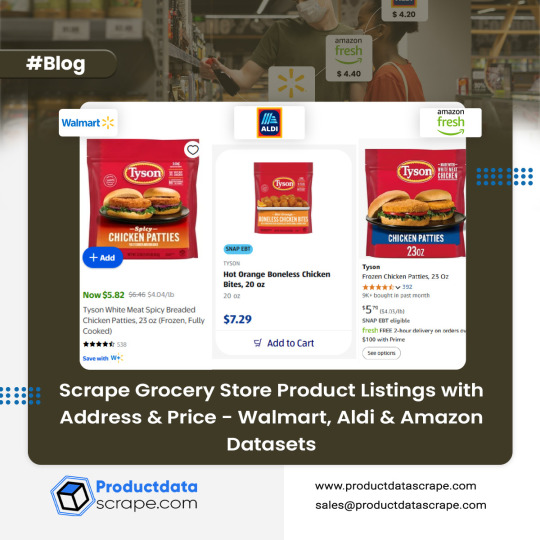
Scrape Grocery Store Product Listings with Address & Price to analyze Walmart, Aldi & Amazon grocery datasets for smarter pricing, local stock & market trends.
#ScrapeGroceryStoreProductListingsWithAddressAndPrice#SupermarketProductPriceAndLocationDataset#GroceryDataAPIWithStoreAddressAndDepartmentInfo#GroceryRetailDataExtractionAPIWithProductAndStoreInfo#ScrapeGroceryProductListingsFromMultipleRetailers#QuickCommerceGroceryAndFMCGDataScraping#ScrapeGroceryAndGourmetFoodData
0 notes
Text
#WebScrapingTopSellingGroceryProductDataFromKroger#WebScrapingKrogerGroceryInventoryData#ScrapeKrogerGroceryProductListingsAndPriceData#ExtractKrogerGroceryAndGourmetFoodData#QuickCommerceGroceryAndFMCGDataScraping#ScrapeGroceryAndGourmetFoodData
0 notes
Text
Web Scraping Top Selling Grocery Product Data From Kroger

Introduction
This case study highlights how our Real-Time Nordstrom Product Data Scraping API enabled a leading fashion analytics firm to optimize its retail intelligence strategy. The client needed up-to-the-minute data on Nordstrom's product inventory, pricing, discounts, and new arrivals to keep their trend forecasting tool accurate and competitive. Our API provided continuous, structured access to thousands of SKUs across categories like apparel, shoes, and accessories. By integrating our solution, the client reduced manual tracking time by 80% and significantly improved product recommendation accuracy. With seamless integration and instant scalability, our Nordstrom Web Scraping API for Product Listings delivered clean, reliable data to fuel machine learning models and real-time dashboards. This empowered the client to make faster, data-driven decisions, improving customer satisfaction and driving measurable growth in their analytics platform's value proposition.
The Client
The client, a U.S.-based retail analytics and supply chain optimization company, approached us to streamline their product tracking capabilities across major supermarket chains. They specifically required Web Scraping Kroger Grocery Inventory Data expertise to monitor fast-moving SKUs, price changes, and regional availability. Their in-house tools were inconsistent and lacked the scale needed for real-time operations. They chose our services to Scrape Kroger Grocery Product Listings & Price Data in a structured, automated, and scalable format. Our ability to Extract Kroger Grocery & Gourmet Food Data with high accuracy across various categories—including fresh produce, packaged goods, and seasonal items—was a key differentiator. They needed clean, ready-to-analyze data feeds to improve their forecasting models and make more informed pricing, assortment, and promotion decisions.
Key Challenges

The client faced several challenges before implementing our solution. Their legacy tools could not consistently capture dynamic product listings and prices from Kroger's evolving online storefront. Frequent layout changes, JavaScript-heavy pages, and regional variations led to incomplete and outdated data. They lacked a reliable Kroger Grocery Data Scraping API to fetch structured data in real-time, which impacted their market responsiveness. Additionally, they struggled to maintain a clean and comprehensive Kroger Grocery Store Dataset for ongoing analysis. Their internal team struggled to scale efforts across thousands of SKUs without a purpose-built Kroger Grocery Product Data Scraper. With the rapid rise of instant delivery platforms, their inability to track inventory and pricing in real-time also limited their visibility in the Quick Commerce Grocery & FMCG Data Scraping space. These challenges hindered their pricing intelligence, product planning, and competitive benchmarking efforts.
Key Solutions

We delivered a customized solution to Scrape Grocery & Gourmet Food Data directly from Kroger's online store to resolve the client's data challenges. Our system leveraged advanced crawling techniques, dynamic rendering, and proxy management to ensure accurate and region-specific data capture. We built a robust Web Scraping Grocery Price Data pipeline, covering real-time updates on discounts, pricing shifts, stock levels, and promotional bundles. The solution included daily automated jobs and error detection to maintain data integrity at scale. We also provided enriched metadata for each product, including nutritional details, brand classification, and customer ratings. The client can access a reliable, structured dataset that seamlessly integrates with their analytics dashboard through our Supermarket Data Scraping Services. This empowered them to improve pricing intelligence, refine stock optimization strategies, and track fast-moving consumer goods (FMCG) performance across multiple regional markets.
Advantages of Collecting data Using product Data Scrape

Real-Time Accuracy: We deliver up-to-date product, pricing, and stock availability data, enabling clients to react instantly to market changes.
Scalable Infrastructure: Our scraping solutions handle thousands of SKUs across multiple regions, ensuring consistent performance even during high-traffic periods.
Custom Data Fields: We extract detailed attributes like nutritional info, ratings, promotions, and variants to meet business needs.
Seamless Integration: Our structured datasets and APIs are designed for easy integration with BI tools, dashboards, and inventory systems.
Competitive Intelligence: Clients gain deep visibility into competitor pricing, assortment strategies, and trends, helping them stay ahead in the retail and FMCG landscape.
Client’s Testimonial
“Partnering with this team has significantly elevated our retail analytics capabilities. Their ability to deliver accurate, real-time grocery data from Kroger was precisely what we needed. The quality of data, coverage across regions, and seamless integration into our internal systems were impressive. We now make quicker, data-driven decisions on pricing and assortment. Their responsive support and technical flexibility made the entire engagement smooth and productive. We highly recommend their services to any company needing scalable and reliable supermarket data scraping."
— Jonathan Reed, Director of Data Strategy
Final Outcome
The final results delivered exceptional value to the client's retail intelligence operations. With our Grocery Data Scraping Services, they now receive accurate, real-time data on over 50,000 SKUs from Kroger's digital storefront. This empowered their analysts to identify pricing gaps, track fast-moving items, and respond swiftly to market changes. The structured and enriched Grocery Store Dataset integrated seamlessly into their analytics platform, supporting trend forecasting, inventory planning, and competitor benchmarking. Daily automated updates ensured consistent visibility into promotions and regional availability. As a result, the client reported a 35% improvement in promotional efficiency and a 50% reduction in manual data gathering efforts. Our solution enhanced their pricing strategy, improved operational agility, and enabled a stronger data-driven approach across departments, ultimately boosting their competitiveness in the fast-paced retail and FMCG sector.
Explore Details >>>https://www.productdatascrape.com/web-scraping-top-selling-grocery-product-data-kroger.php
#WebScrapingTopSellingGroceryProductDataFromKroger#WebScrapingKrogerGroceryInventoryData#ScrapeKrogerGroceryProductListingsAndPriceData#ExtractKrogerGroceryAndGourmetFoodData#QuickCommerceGroceryAndFMCGDataScraping#ScrapeGroceryAndGourmetFoodData
0 notes
Text
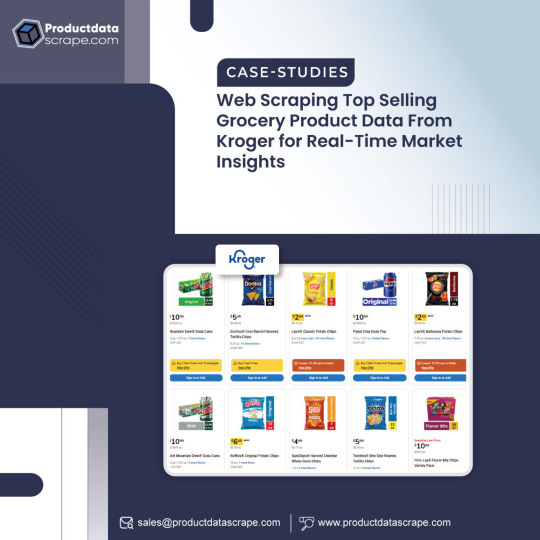
Web Scraping Top Selling Grocery Product Data From Kroger enables real-time insights into pricing, trends, and demand.
#WebScrapingTopSellingGroceryProductDataFromKroger#WebScrapingKrogerGroceryInventoryData#ScrapeKrogerGroceryProductListingsAndPriceData#ExtractKrogerGroceryAndGourmetFoodData#QuickCommerceGroceryAndFMCGDataScraping#ScrapeGroceryAndGourmetFoodData
0 notes
Text
#ExtractTopSellingGroceryProductDataFromKroger#KrogerSupermarketDataScrapingServices#ScrapeHighDemandGroceryProductsDataFromKroger#KrogerTopProductListingsDataScrapingAPI#WebScrapingKrogerGroceryProductListingsAndPriceData#QuickCommerceGroceryAndFMCGDataScraping
0 notes
Text
Extract Top Selling Grocery Product Data From Kroger

Introduction
In today’s hyper-competitive grocery landscape, staying ahead of price shifts, assortment gaps, and local demand trends is no longer optional — it’s essential. For modern retailers, suppliers, and brands that rely on accurate data to drive decisions, the power to Extract Top Selling Grocery Product Data From Kroger can make or break their market edge. By tapping into Kroger’s real-time product trends, you gain an instant view of which SKUs are driving volume, which categories need expansion, and where pricing adjustments can protect margins. Instead of relying on outdated reports, smart companies use live Kroger data to move from static pricing to agile, responsive strategies that match shifting consumer behavior and outpace competitors daily.
Why Extract Top Selling Grocery Product Data From Kroger?

Kroger stands as one of America’s biggest supermarket chains — with thousands of stores, millions of SKUs, and local demand patterns that shift daily. For any retailer, supplier, or brand, the ability to Extract Top Selling Grocery Product Data From Kroger means you’re not relying on outdated spreadsheets or guesswork — you’re acting on real, shelf-level facts.
Spot High-Performing SKUs by Region
When you Extract Top Selling Grocery Product Data From Kroger, you uncover which products dominate sales in specific cities or neighborhoods. One SKU might be a top seller in the Midwest but underperform on the West Coast. With this insight, you adjust assortments, promotions, and regional stock levels to match actual demand.
Understand What Drives Repeat Purchases
By combining Kroger’s live product data with Kroger Supermarket Data Scraping Services, businesses see not just top-line sales but repeat purchase patterns. Is a high-demand product seasonal, or does it drive loyalty year-round? Knowing this helps brands plan production, run targeted loyalty campaigns, and build deeper baskets.
React to Promotions and Dynamic Pricing
Kroger uses dynamic pricing to stay competitive. When you have real-time visibility, you see which promotions are pulling customers away from your brand. This lets you match offers, tweak discounts, and avoid losing market share to aggressive local pricing moves.
Feed Smart Planning and Forecasting
Combining Scrape Kroger Grocery Inventory Data, Kroger Grocery Store Dataset, and a clean data pipeline means every department — from merchandising to supply chain — has fresh facts to plan smarter. Better data equals faster stock turns and fewer lost sales.
How We Scrape Kroger Data for Assortment & Pricing Insights?
When you Extract Top Selling Grocery Product Data From Kroger, you’re tapping a goldmine of real-time product trends that fuel smarter pricing and assortment moves. At Product Data Scrape, we empower retailers and suppliers to Scrape Kroger Grocery Inventory Data daily — not just top-line prices but also hyperlocal stock levels, promotions, and new SKU launches.
Our Kroger Grocery Data Scraping API plugs directly into Kroger’s online footprint, capturing SKU-level updates, stock shifts, and dynamic price changes automatically. This real-time feed removes the guesswork that used to slow down category managers. Now, they can adjust store displays, e-commerce listings, and promotions daily instead of quarterly.
Alongside core inventory data, we help brands Scrape High-Demand Grocery Products Data from Kroger to pinpoint seasonal peaks and local fads. For example, a snack brand might see a sudden 30% surge in a new flavor in a certain ZIP code — intel they can’t afford to miss. This intelligence is further refined with our Kroger Top Product Listings Data Scraping API, which tracks top-ranked SKUs across all major categories, ensuring your assortment aligns with what shoppers really want.

Analysis:
The volume of SKUs being scraped every month is rising fast as brands shift from periodic reports to real-time feeds. This improves speed to shelf, reduces out-of-stock gaps, and keeps pricing relevant. When you combine this live stream with clean Kroger Grocery Store Dataset integrations, you gain full control of local pricing and on-shelf availability. Product Data Scrape’s tools make it easy to pull Kroger trends into your daily workflows without slowing your team down.
Start extracting Kroger data today to fix assortment gaps, adjust pricing in real time, and stay ahead of fast-changing shopper trends.
Beyond Basics: Deep Data for Modern Grocery Retail
Going beyond simple price checks is where real ROI happens. Retailers who Extract Top Selling Grocery Product Data From Kroger plus premium segments get a blend of everyday staples and profitable gourmet lines.
By combining Web Scraping Kroger Grocery Product Listings & Price Data with Extract Kroger Grocery & Gourmet Food Data, you’re not just filling shelves — you’re curating assortments that lift margins. Are more shoppers buying organic, vegan, or global imports? Real-time feeds show what’s trending locally so you can expand premium lines first.
Modern teams also overlay Quick Commerce Grocery & FMCG Data Scraping with Kroger trends. This ensures your online dark store or rapid delivery app reflects exactly what’s hot on local Kroger shelves — a must for staying relevant in the 10–30-minute delivery race.
All this data flows into your Kroger Grocery Store Dataset, fueling AI-driven forecasting and promotional planning. When you Scrape High-Demand Grocery Products Data from Kroger, you know exactly when to run a flash sale or push a bundled offer.

Analysis:
High-margin gourmet segments are expanding. Without accurate scraping of niche SKUs, you’ll miss what shoppers are willing to pay more for. A smart Kroger Grocery Product Data Scraper makes sure you profit from every trend.
Pair Kroger Insights with Broader Grocery & Supermarket Data Scraping Services
Relying on one chain’s data limits your edge. By pairing Kroger with wider Grocery & Supermarket Data Scraping Services, you see the true market landscape. What’s a top seller at Kroger might be priced lower or stocked differently at a regional grocer.
This is where brands plug Supermarket Data Scraping Services into their stack. With cross-retailer views, you catch pricing gaps, undercut competitors, or plug assortment holes instantly. The same tools that help you Extract Top Selling Grocery Product Data From Kroger also cover other chains, so your team sees the big picture — not a Kroger silo.
Combine this with Web Scraping Grocery Price Data, and you feed real-time competitor prices into your dynamic pricing engines. Are you $0.30 higher than a nearby store? Adjust fast before shoppers switch.

Analysis:
Retailers using multi-chain insights win on pricing, stock, and promotions. A Grocery Store Dataset that covers multiple brands isn’t a nice-to-have — it’s a market edge.
Automate Assortment Refresh with Kroger Top Product Listings Data Scraping API
Nothing hurts profits like empty shelves or stale assortments. With the Kroger Top Product Listings Data Scraping API, you detect sudden jumps in product rank or new trending SKUs instantly. Instead of slow weekly reviews, your team gets daily freshness.
Pair this with Scrape High-Demand Grocery Products Data from Kroger, and your team can renegotiate supply faster, secure extra stock, and launch local deals while demand is peaking — not after it’s over.
Smart retailers plug this feed into their broader Kroger Supermarket Data Scraping Services, so insights reach every store format: big-box, neighborhood, and click-and-collect.

Analysis:
Automated assortment tracking is proven to grow revenue. Using a Kroger Grocery Product Data Scraper to catch these signals protects margins and keeps your promotions relevant — all while saving your category team hours every week.
Automate your assortment updates with our Kroger Top Product Listings Data Scraping API and never miss a trending SKU again.
Expand Gourmet Range with Extract Kroger Grocery & Gourmet Food Data
Gourmet and specialty segments keep margins strong. When you Extract Kroger Grocery & Gourmet Food Data, you see which niche brands or premium SKUs outperform others. Maybe a new organic pasta line is selling out in urban ZIP codes but not yet stocked nationwide — with this intel, you scale smarter.
Retailers pair this with Quick Commerce Grocery & FMCG Data Scraping to test gourmet assortments in local dark stores. When demand spikes, same-day delivery captures premium shoppers who want top-tier products, fast.

Analysis:
High-margin gourmet goods now make up nearly a third of baskets for some shoppers. Use Kroger Supermarket Data Scraping Services and premium data to expand smartly and protect profitability.
Dynamic Pricing Powered by Web Scraping Grocery Price Data
Kroger adjusts prices in real time — your business should too. By integrating Web Scraping Grocery Price Data, your dynamic pricing tools respond instantly to local price moves, promotions, and undercuts.
Combined with our Kroger Grocery Data Scraping API, you’re always one step ahead. Detect a price drop? Match it within hours, not days.Year% Retailers Using Dynamic PricingAvg.

Analysis:
Dynamic pricing powered by real-time scraping keeps revenue up and customer churn down. With Grocery Data Scraping Services, you keep your price advantage daily.
Why Choose Product Data Scrape?
With Product Data Scrape, you’re not just buying scrapers — you’re investing in a battle-tested data partner. From tailored Kroger Supermarket Data Scraping Services to seamless plug-ins for your BI dashboards, you get data that’s accurate, scalable, and ready for your entire pricing and merchandising team. Our experts ensure your feeds include everything — store-level pricing, inventory snapshots, shelf tags, and historical trends. Whether you want to Scrape Kroger Grocery Inventory Data, automate feeds through our Kroger Grocery Data Scraping API, or add other chains to your tracking with Grocery & Supermarket Data Scraping Services, you get data that unlocks real savings and profit — not just a messy file.
Conclusion
It’s simple: To win the shelf war, you need real numbers, not old reports. Smart brands Extract Top Selling Grocery Product Data From Kroger to fix assortment gaps, stay ahead of pricing moves, and protect margins every day. Start with Product Data Scrape today — and transform your grocery strategy from reactive to proactive.
Explore More >>https://www.productdatascrape.com/extract-top-selling-grocery-data-kroger.php
#ExtractTopSellingGroceryProductDataFromKroger#KrogerSupermarketDataScrapingServices#ScrapeHighDemandGroceryProductsDataFromKroger#KrogerTopProductListingsDataScrapingAPI#WebScrapingKrogerGroceryProductListingsAndPriceData#QuickCommerceGroceryAndFMCGDataScraping
0 notes
Text
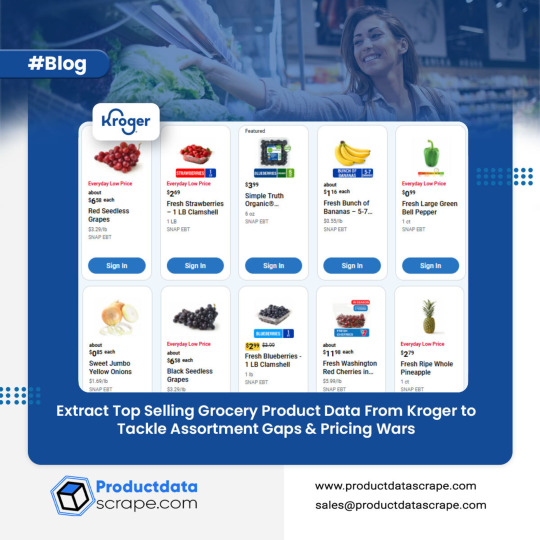
#ExtractTopSellingGroceryProductDataFromKroger#KrogerSupermarketDataScrapingServices#ScrapeHighDemandGroceryProductsDataFromKroger#KrogerTopProductListingsDataScrapingAPI#WebScrapingKrogerGroceryProductListingsAndPriceData#QuickCommerceGroceryAndFMCGDataScraping
0 notes
Text
#WebScrapingGroceryPricesFromSanFranciscoStores#ExtractGroceryPricesFromSanFranciscoSupermarkets#GroceryStoreDataExtractionFromSanFrancisco#ExtractGroceryPricesFromSanFranciscoStores#ScrapeGroceryAndGourmetFoodData#QuickCommerceGroceryAndFMCGDataScraping
0 notes
Text
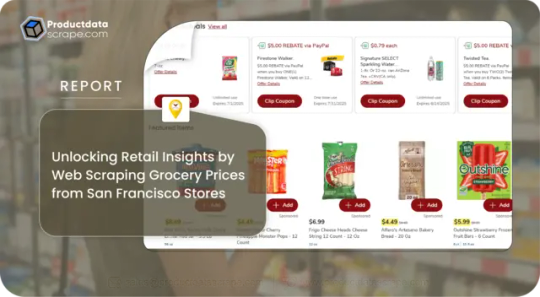
Introduction
In today’s digitally driven world, e-commerce has revolutionized global retail by providing unmatched convenience and accessibility. Behind the smooth online shopping experience, however, lies a complex and ever-evolving supply chain. The success of an e-commerce platform hinges on its ability to optimize supply chain operations, which include inventory management, supplier coordination, logistics, and delivery. This is where E-commerce supply chain data scraping plays a crucial role. By utilizing web scraping for supply chain insights, businesses can gain valuable data from various sources to improve decision-making and enhance operational efficiency. Supply chain optimization with data scraping enables companies to stay ahead of competitors by streamlining processes, reducing costs, and ensuring timely deliveries. By tapping into valuable data from suppliers, competitors, and customers, businesses can refine their strategies, forecast demand, and maintain a competitive edge in the rapidly evolving e-commerce industry.
Understanding E-commerce Supply Chain Data Scraping
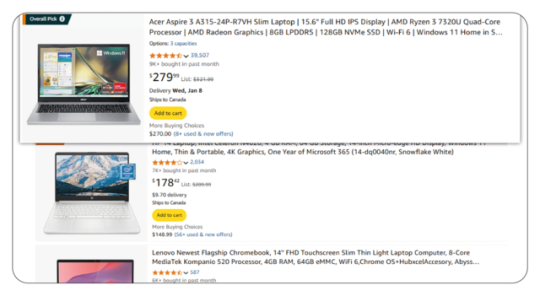
E-commerce supply chain data scraping involves extracting valuable information from various online sources related to supply chain operations. This data can encompass supplier details, product availability, pricing trends, shipment tracking, customer feedback, and competitor strategies. By leveraging web scraping technologies, businesses can collect, analyze, and utilize this data to make data-driven decisions, streamline operations, and enhance customer satisfaction.
E-commerce logistics data extraction is vital in tracking shipment progress and delivery timelines, ensuring businesses meet customer expectations. Real-time supply chain data scraping informs companies about inventory levels, disruptions, and other critical factors that may impact operations. Product availability data scraping also enables businesses to monitor stock levels across multiple platforms and suppliers, ensuring they maintain sufficient inventory to meet customer demand.
Benefits of E-commerce Supply Chain Data Scraping
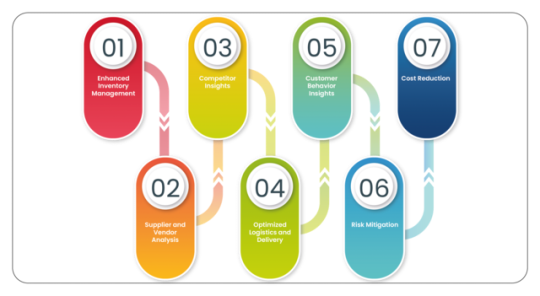
E-commerce supply chain data scraping offers businesses valuable insights into enhancing efficiency, optimizing inventory, tracking competitor strategies, and improving customer satisfaction. By leveraging real-time data, companies can streamline operations, reduce costs, and make informed decisions to stay competitive.
1. Enhanced Inventory Management: Effective inventory management is a cornerstone of successful e-commerce operations. Data scraping allows businesses to monitor stock levels, track product demand, and predict future trends. By analyzing historical and real-time data, companies can avoid overstocking or understocking situations, reducing storage costs and improving customer satisfaction. For instance, scraping competitor websites for product availability data provides insights into market demand and helps businesses align their inventory strategies accordingly. Additionally, analyzing seasonal trends through scraped data enables companies to effectively plan for peak demand periods. This is part of the broader approach of supply chain efficiency with data extraction, ensuring smooth operations.
2. Supplier and Vendor Analysis: The foundation of a robust supply chain lies in reliable suppliers and vendors. E-commerce businesses can use data scraping to gather information about potential suppliers, their pricing, delivery schedules, and reputation. This information aids in selecting the best partners and negotiating favorable terms. Furthermore, regular scraping of supplier websites helps monitor price fluctuations, ensuring businesses procure raw materials and products at competitive rates. It also enables companies to identify alternative suppliers in case of disruptions, reducing dependency on a single source. Companies can extract e-commerce data on vendor performance, fostering better relationships and informed decisions.
3. Competitor Insights: In the highly competitive e-commerce landscape, staying ahead of competitors is crucial. Supply chain data scraping allows businesses to track competitor strategies, pricing models, and promotional activities. By analyzing this data, companies can identify market gaps, refine their pricing strategies, and develop unique value propositions. For example, monitoring competitors’ shipping times and logistics partners can reveal areas where a business can outperform them. This data also supports the identification of emerging trends, enabling companies to adapt and innovate proactively. Regular web scraping e-commerce websites helps businesses stay agile and informed.
4. Optimized Logistics and Delivery: Efficient logistics and delivery are vital for meeting customer expectations. Data scraping is pivotal in optimizing these processes by providing real-time updates on shipping routes, carrier performance, and delivery times. By scraping tracking information from logistics providers, businesses can identify bottlenecks in the supply chain and implement solutions to enhance efficiency. Moreover, analyzing delivery patterns helps identify regions with high demand, enabling companies to establish localized distribution centers and reduce shipping times. Using eCommerce dataset scraping further refines logistics by offering comprehensive data analysis.
5. Customer Behavior Insights: Understanding customer preferences and behaviors is essential for e-commerce success. Supply chain data scraping facilitates the collection of customer reviews, ratings, and feedback from various platforms. This data provides valuable insights into product quality, delivery experiences, and areas for improvement. Businesses can refine their offerings by analyzing customer sentiment, addressing pain points, and building stronger relationships with their target audience. Additionally, this data helps predict future demand patterns and tailor marketing strategies to specific customer segments. Price monitoring through customer feedback helps businesses adjust to market conditions.
6. Risk Mitigation: Supply chain disruptions can have far-reaching consequences for e-commerce businesses. Data scraping aids in identifying potential risks by monitoring external factors such as geopolitical events, natural disasters, and regulatory changes. For instance, scraping news sources and industry reports provides insights into supply chain vulnerabilities and enables companies to develop contingency plans. By staying informed about global events, businesses can proactively adjust their supply chain strategies to minimize disruptions. Proactive web scraping e-commerce websites for risk-related updates is key to maintaining resilience.
7. Cost Reduction: One significant advantage of supply chain data scraping is its ability to uncover cost-saving opportunities. Businesses can identify areas where expenses can be minimized by analyzing pricing data, shipping rates, and operational inefficiencies. For example, scraping competitor data for pricing trends allows companies to set competitive prices while maintaining profitability. Similarly, monitoring logistics costs through scraped data helps select cost-effective shipping options without compromising delivery speed. This is essential to pricing strategies, ensuring sustainable growth and efficiency.
Ethical and Legal Considerations
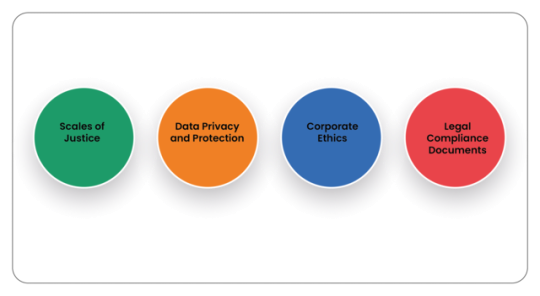
While supply chain data scraping offers numerous benefits, it is essential to approach it ethically and within legal boundaries. Businesses must respect website terms of service, obtain permission where required, and ensure compliance with data protection regulations.
Adopting ethical scraping practices mitigates legal risks and fosters trust with partners and customers. Companies should prioritize data accuracy, transparency, and security to maintain a positive reputation in the industry.
Future of E-commerce Supply Chain Data Scraping

As technology advances, the future of e-commerce supply chain data scraping holds immense potential. Artificial intelligence (AI) and machine learning (ML) are expected to play a pivotal role in enhancing the efficiency and accuracy of data scraping processes.
AI-powered tools can analyze vast amounts of data in real time, providing actionable insights for supply chain optimization. Predictive analytics, enabled by ML algorithms, will further enhance demand forecasting, inventory planning, and risk assessment.
Additionally, the integration of blockchain technology with supply chain data scraping is on the horizon. Blockchain offers enhanced transparency and traceability, ensuring the authenticity of scraped data and improving trust across the supply chain network.
Conclusion
E-commerce supply chain data scraping is a game-changer for businesses seeking to thrive in a fast-paced and competitive market. By leveraging scraped data, companies can gain valuable insights into inventory management, supplier performance, logistics optimization, and customer behavior.
The benefits of supply chain data scraping extend beyond operational efficiency to include cost reduction, risk mitigation, and enhanced decision-making. However, ethical considerations and compliance with legal regulations are paramount to ensure responsible and sustainable data scraping practices.
As technology evolves, the potential of supply chain data scraping will continue to expand, empowering e-commerce businesses to adapt to changing market dynamics and deliver exceptional customer experiences. By embracing this transformative approach, companies can unlock new opportunities, drive growth, and establish themselves as leaders in the e-commerce industry.
At Product Data Scrape, we strongly emphasize ethical practices across all our services, including Competitor Price Monitoring and Mobile App Data Scraping. Our commitment to transparency and integrity is at the heart of everything we do. With a global presence and a focus on personalized solutions, we aim to exceed client expectations and drive success in data analytics. Our dedication to ethical principles ensures that our operations are both responsible and effective.
Source >>https://www.productdatascrape.com/web-scraping-grocery-prices-san-francisco-retail-insights.php
#WebScrapingGroceryPricesFromSanFranciscoStores#ExtractGroceryPricesFromSanFranciscoSupermarkets#GroceryStoreDataExtractionFromSanFrancisco#ExtractGroceryPricesFromSanFranciscoStores#ScrapeGroceryAndGourmetFoodData#QuickCommerceGroceryAndFMCGDataScraping
0 notes
Text
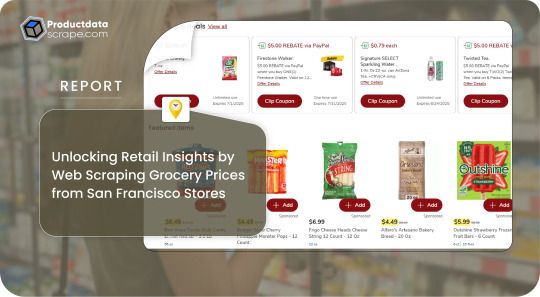
Web Scraping Grocery Prices from San Francisco Stores enables real-time insights into pricing, trends, and retail competition.
Source >>https://www.productdatascrape.com/web-scraping-grocery-prices-san-francisco-retail-insights.php
#WebScrapingGroceryPricesFromSanFranciscoStores#ExtractGroceryPricesFromSanFranciscoSupermarkets#GroceryStoreDataExtractionFromSanFrancisco#ExtractGroceryPricesFromSanFranciscoStores#ScrapeGroceryAndGourmetFoodData#QuickCommerceGroceryAndFMCGDataScraping
0 notes
Text
Quick Commerce Grocery & FMCG Data Scraping
#QuickCommerceDataScrapingForAccurateMarketInsights#QuickCommerceDataScrapingByLeveragingRealTimeInsights#QuickCommerceGroceryAndFMCGDataScraping#ExtractQuickCommerceProductData#ExtractQuickCommercePlatformInsightsofferingACompetitiveEdge.#QuickCommerceDataExtractionServicesToCollectValuableProductData
0 notes